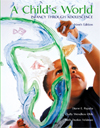 A Child's World: Infancy through Adolescence, 9/e Diane E. Papalia,
University of Wisconsin-Madison
Sally Wendkos Olds
Ruth Duskin Feldman
Psychosocial Development during the First Three Years
Chapter Outline
Section I Foundations of Psychosocial Development
EmotionsEarly Signs of EmotionWhen Do Various Emotions Develop?Brain Growth and Emotional Development
TemperamentAspects and Patterns of Temperament: New York Longitudinal StudyEffects of Temperament on Adjustment: "Goodness of Fit"How is Temperament Measured?How Stable is Temperament?Biological Bases of temperamentCross-Cultural differences
Earliest Social Experiences: The Infant in the FamilyThe Mother's RoleThe Father's RoleHow Parents Shape Gender DifferencesGrandparent's Role |
 |  |  | Section II Developmental Issues in Infancy
Developing Trust
Developing AttachmentsStudying Patterns of AttachmentHow Attachment Is EstablishedThe Role of TemperamentIntergenerational Transmission of Attachment PatternsStranger Anxiety and Separation AnxietyLong-Term Effects of Attachment
Emotional Communication with Caregivers: Mutual RegulationHow a Mother's Depression Affects Mutual Regulation
Social Referencing |
 |  |  | Section III Developmental Issues in Toddlerhood
The Emerging Sense of Self
Developing Autonomy
Socialization and Internalization: Developing a ConscienceDeveloping Self-RegulationOrigins of Conscience: Committed ComplianceFactors in the Success of Socialization |
 |  |  | Section IV Contact With Other Children
SiblingsThe Arrival of a New BabyHow Siblings Interact
Sociability with Nonsiblings |
 |  |  | Section V Children of Working Parents
Effect of Parental employment
The Impact of Early child Care |
| 


 2002 McGraw-Hill Higher Education
2002 McGraw-Hill Higher Education